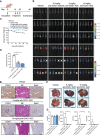DOG1 as a novel antibody-drug conjugate target for the treatment of multiple gastrointestinal tumors and liver metastasis
- PMID: 36776873
- PMCID: PMC9909470
- DOI: 10.3389/fimmu.2023.1051506
DOG1 as a novel antibody-drug conjugate target for the treatment of multiple gastrointestinal tumors and liver metastasis
Abstract
Discovered On Gastrointestinal stromal tumors protein 1 (DOG1), a major calcium-activated chloride channel, has been used as a common diagnostic marker for gastrointestinal stromal tumors. However, the therapeutic application of DOG1 was not well defined. Here, we aim to investigate its potential as a therapeutic target for an antibody-drug conjugate (ADC) in various cancers of the alimentary tract and metastasis. The DOG1 expression profile was determined among TCGA samples and tissue microarrays. High levels of DOG1 expression were ubiquitously observed in multiple cancer samples from the alimentary tract determined by TCGA samples and tissue microarrays. Circulating tumor cells isolated from metastatic colon cancer patients were also positive for DOG1 expression. The mechanisms of anti-DOG1 antibody were investigated by dual-luciferase reporter assay. The anti-DOG1 antibody could inhibit proliferation and metastasis via p53 signaling in limited cancer cell lines. The anti-DOG1 antibody was conjugated with a microtubule inhibitor DM4, to construct a new anti-DOG1-DM4-ADC to strengthen its activity. The anti-DOG1-DM4-ADC showed cytotoxicity at the nanomolar level in vitro. In the murine xenograft tumor models, treatment of anti-DOG1-DM4-ADC achieved a significant tumor growth inhibition rate. Our study indicates that anti-DOG1-DM4-ADC may be promising therapeutic molecules for DOG1-positive alimentary tract tumors and may be effective in inhibiting recurrence after curative resection of liver metastases of colorectal origin.
Keywords: DOG1; GIST; alimentary tract cancers; antibody-drug conjugate; liver metastasis.
Copyright © 2023 Wu, Li, Chen, Wang, Su, Xu, Deng, Yang, Wei, Li, Liu, Yang and Li.
Conflict of interest statement
The authors declare that the research was conducted in the absence of any commercial or financial relationships that could be construed as a potential conflict of interest.
Figures






Similar articles
-
Functional role of the Ca²⁺-activated Cl⁻ channel DOG1/TMEM16A in gastrointestinal stromal tumor cells.Exp Cell Res. 2014 Aug 15;326(2):315-25. doi: 10.1016/j.yexcr.2014.05.003. Epub 2014 May 10. Exp Cell Res. 2014. PMID: 24825187
-
Targeting of DDR1 with antibody-drug conjugates has antitumor effects in a mouse model of colon carcinoma.Mol Oncol. 2019 Sep;13(9):1855-1873. doi: 10.1002/1878-0261.12520. Epub 2019 Jul 22. Mol Oncol. 2019. PMID: 31116512 Free PMC article.
-
DOG1 antibody in the differential diagnosis of gastrointestinal stromal tumors: a study of 1840 cases.Am J Surg Pathol. 2009 Sep;33(9):1401-8. doi: 10.1097/PAS.0b013e3181a90e1a. Am J Surg Pathol. 2009. PMID: 19606013
-
The utility of discovered on gastrointestinal stromal tumor 1 (DOG1) antibody in surgical pathology-the GIST of it.Adv Anat Pathol. 2010 May;17(3):222-32. doi: 10.1097/PAP.0b013e3181d973c2. Adv Anat Pathol. 2010. PMID: 20418677 Review.
-
Is DOG1 Immunoreactivity Specific to Gastrointestinal Stromal Tumor?Cancer Control. 2015 Oct;22(4):498-504. doi: 10.1177/107327481502200416. Cancer Control. 2015. PMID: 26678977 Review.
Cited by
-
Drug conjugates for the treatment of lung cancer: from drug discovery to clinical practice.Exp Hematol Oncol. 2024 Mar 1;13(1):26. doi: 10.1186/s40164-024-00493-8. Exp Hematol Oncol. 2024. PMID: 38429828 Free PMC article. Review.
-
Advances in the diagnosis and treatment of MET-variant digestive tract tumors.World J Gastrointest Oncol. 2024 Nov 15;16(11):4338-4353. doi: 10.4251/wjgo.v16.i11.4338. World J Gastrointest Oncol. 2024. PMID: 39554732 Free PMC article. Review.
-
The role of anoctamin 1 in liver disease.J Cell Mol Med. 2024 May;28(9):e18320. doi: 10.1111/jcmm.18320. J Cell Mol Med. 2024. PMID: 38685684 Free PMC article. Review.
References
-
- Bill A, Gaither LA. Ano1 as a novel drug target. Transporters as Drug Targets (2017), 231–52. doi: 10.1002/9783527679430.ch10 - DOI
Publication types
MeSH terms
Substances
LinkOut - more resources
Full Text Sources
Other Literature Sources
Medical
Research Materials
Miscellaneous

